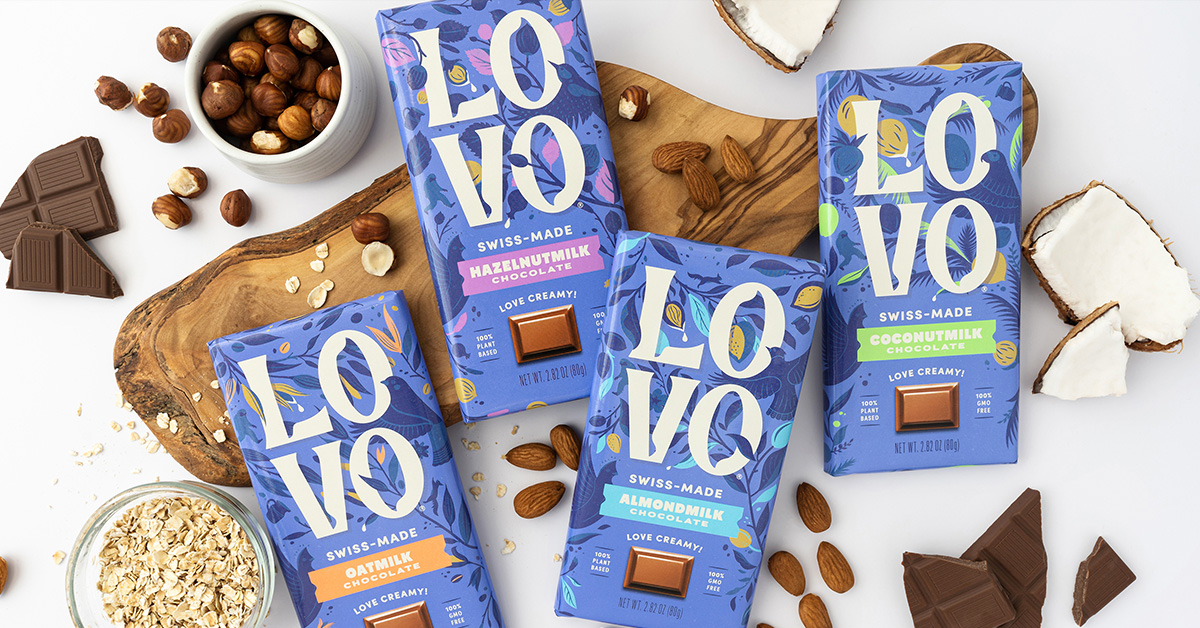Why LOVO Chocolate Markets Plant-based Milk Varietals, Swiss Origin

Nowadays, plant-based milk chocolate is plentiful with a market full of alternatives to traditional formats and flavor combinations. Within that landscape, LOVO Chocolate has honed a unique position, aiming to “punch out” a new arena that embraces traditional chocolate-making techniques while elevating the flavor profiles of various plant milks.
“We set out originally on the wrong path – originally we tried to make it taste like milk chocolate,” explained co-founder Courtenay Vuchnich, noting that the brand concept had been in incubation for nearly six years.
Launched online in 2023 by Vuchnich and Simon Lester, who are also the founders of dark chocolate brand Pascha, the brand has secured substantial support for its 4-SKU milk chocolate bar line with a footprint spanning 1,500 retailers nationwide including Safeway, Albertsons, Fairway and more.
“We knew from the beginning we wanted it to be plant milk. We wanted it to be vegan, but we wanted it to be really for the flexitarian – the person who wants something that’s better in a category without giving anything up. It’s not like the chocolate consumer is unhappy with their chocolate,” Vuchnich said.
Making Alt-Milk Chocolate
LOVO’s products, which include Almondmilk, Coconutmilk, Hazelnutmilk and Oatmilk varieties, were crafted in the homeland of milk chocolate: Switzerland. The products are sweetened with beet sugar, contain Rainforest Alliance-certified cocoa and carry an SRP of $4.49 to $5.49 per 2.8 oz. bar. Earlier this summer, LOVO expanded to 260 Walmart stores across the Midwest and Florida.
“We’re happy that there’s been interest across different channels from natural to specialty to mainstream, grocery to mass, and online as well, [both on] Instacart or Amazon,” she added. “At this point we’re really focused on the accounts where we are and how we continue to get the consumer to pick up the product.”
Vuchnich said she always had an interest in alternative milks and was keeping a close eye on the liquid alt-milk category’s growth while LOVO was still in its R&D stage. In that time, Vuchnich learned that within a single household, consumers often buy multiple different plant-based milks for distinct purposes.
That’s when she said she had an epiphany: “We could make our line taste like the beautiful, deep, nutty, creamy taste of these plant milks. That’s the moment where we said, ‘Let’s pivot. Let’s figure out a different approach. Let’s look at it entirely upside down.”
Alt-milk category dollar sales rose 8.8% year-over-year by the end of 2023, according to Circana. She said the fact that plant-based milks had gained so much traction so quickly served as another key point of validation: “That never would have happened if the U.S. consumer felt like they were compromising on taste.”
‘Punching Out’ New Product Types
The remaining challenge is figuring out how to translate why consumers purchase an array of plant milk – most often to be used as ingredients – and win over the “passionate” chocolate consumer who “cares deeply” about the mouthfeel and creaminess of their desired cocoa, Vuchnich explained. Within LOVO’s lineup, different varieties are more decadent than others, she said, offering consumers the same choice they are used to in the liquid alt-milk set.
“We were determined to make the category larger – punch it out into a different room. We felt like the consumer was ready for this sort of product,” Vuchnich emphasized.
In order to do that, the brand is speaking directly to its primary consumer group – women – through a new commercial spot that intends to embrace the ethos of why this demographic purchases chocolate in the first place. LOVO’s “Dreamscape” manages to highlight the brand’s Swiss origins, flavor approach and the “ritualistic” nature of chocolate consumption for women, Vuchnich said.
The DTC-native brand also debuted a new website design that is in line with the aesthetics and approach of the commercial. Now, Vuchnich said the focus is to get the brand consistently within the reach of its core consumer.
“It sounds simplistic, but we really want to be part of a repertoire of four or five brands that people go to, trust and know that they’re going to have a wonderful chocolate experience with,” Vuchnich said. “We hope that this end of the category continues to grow and that awareness continues to grow on what plant based eating can be and what it offers the consumer.”
Growing Amid Cacao Cost Challenges
But for all of the dreaminess and decadence around chocolate, discussions around the dark side of the category’s supply chain have come into the conversation in recent months. After low yields in key cocoa producing countries including Ghana and the Ivory Coast, prices skyrocketed to an all time high of $11,000 per metric ton in late April and doomsday reports went so far to suggest that chocolate as we know it may soon be extinct.
While prices have moderated a bit, $8,380 per ton as of June, the challenge has impacted all chocolatiers – from large CPGs to small producers to the consumers themselves, Vuchnich emphasized. However, she said, if there is a silver lining, it is that this challenge has put the spotlight on chocolate farmers, giving them a louder voice in the conversation. She believes this experience will result in higher wages for farmers in the long term.
“It’s too bad that this hasn’t happened slowly, but… we believe that some of [these price increases] will go into [the farmer’s] pocket,” she said. “It would be easier on the industry if that happened through a longer period of time. But, [the cacao farmers] role is so critical, not only to the chocolate business, but to our planet, and I feel that the industry is supporting them a bit more.”

















